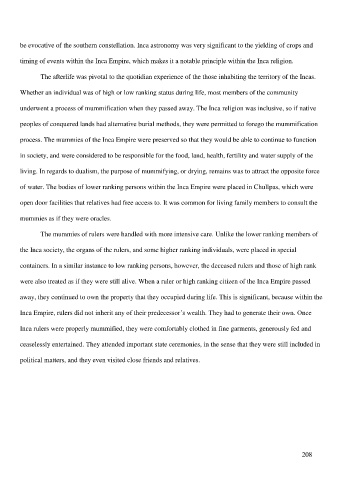Page 208 - ce_cusco_2019
P. 208
be evocative of the southern constellation. Inca astronomy was very significant to the yielding of crops and
timing of events within the Inca Empire, which makes it a notable principle within the Inca religion.
The afterlife was pivotal to the quotidian experience of the those inhabiting the territory of the Incas.
Whether an individual was of high or low ranking status during life, most members of the community
underwent a process of mummification when they passed away. The Inca religion was inclusive, so if native
peoples of conquered lands had alternative burial methods, they were permitted to forego the mummification
process. The mummies of the Inca Empire were preserved so that they would be able to continue to function
in society, and were considered to be responsible for the food, land, health, fertility and water supply of the
living. In regards to dualism, the purpose of mummifying, or drying, remains was to attract the opposite force
of water. The bodies of lower ranking persons within the Inca Empire were placed in Chullpas, which were
open door facilities that relatives had free access to. It was common for living family members to consult the
mummies as if they were oracles.
The mummies of rulers were handled with more intensive care. Unlike the lower ranking members of
the Inca society, the organs of the rulers, and some higher ranking individuals, were placed in special
containers. In a similar instance to low ranking persons, however, the deceased rulers and those of high rank
were also treated as if they were still alive. When a ruler or high ranking citizen of the Inca Empire passed
away, they continued to own the property that they occupied during life. This is significant, because within the
Inca Empire, rulers did not inherit any of their predecessor’s wealth. They had to generate their own. Once
Inca rulers were properly mummified, they were comfortably clothed in fine garments, generously fed and
ceaselessly entertained. They attended important state ceremonies, in the sense that they were still included in
political matters, and they even visited close friends and relatives.
208

